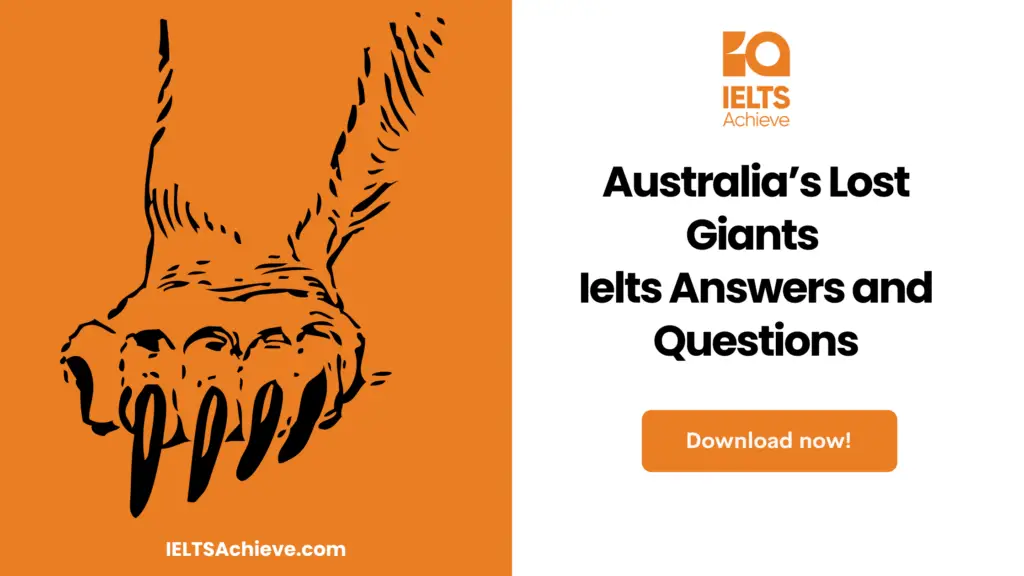The Blog post contains the following IELTS Reading Questions:
- IELTS Reading Locating information
- IELTS Reading multiple choice questions
- IELTS Reading True/False/Not given

IELTS reading passage – Australia’s Lost Giants
Australia’s Lost Giants
A. The Victorian Cave was explored by a fossil hunter named Rod Wells, who came to Naracoorte, South Australia, in 1969. The narrow passages, which were distinctly clawed, led to huge chambers. The ground had red soil, and the floor was bedraggled with strange objects. It took Wells a moment to acknowledge that what he was checking out were the bones of thousands of animals that might have fallen from openings in the ground above and gotten stuck. Compared to the mammals found today in Australia, some of the oldest were far more sizable. These bones belonged to Australian megafauna—giant mammals of the Pleistocene epoch. Across the continent, in boneyards, fossils of a giant snake, a huge flightless bird, and a seven-foot kangaroo, to give some examples, were discovered by scientists. Considering the amount of light cast on the extinction of the dinosaurs, it’s surprising that a little has been discovered about megafauna. Prehistoric humans never harmed Tyrannosaurus rex with spears, although they did hunt mammoths and mastodons.
B. Soon after the arrival of humans, the extinction of megafauna in America, including mammoths, saber-toothed cats, and gigantic sloths, occurred around 13,000 years ago. A paleoecologist named Paul Martin published a hypothesis known as the “blitzkrieg hypothesis” in the 1960s. Modern people caused chaos in the Americas by killing animals with spears. These animals had never seen a smart predator before, so they couldn’t defend themselves.But this period of extinction was not complete. On the continent, North America retained its deer, black bears, and a small type of bison, and on the continent, South America had its jaguars and llamas.
C. It is confounding to witness the melancholy of Australia’s large animals. For quite a long time, researchers put aside any other causes for extinction other than environmental changes. To be sure, Australia has been drying out for more than 1,000,000 years, and the megafauna were confronted with a landmass where vegetation had started to vanish. Tim Flannery, an Australian paleontologist, proposed that people who moved onto the continent around 50 centuries ago used fire to hunt. This was accompanied by deforestation. Something worrisome occurred to Australia’s predominant land animals-somewhere around 46,000 years ago, not long after the intrusion of a profoundly wise hunter with excellent tools.
D. The controversy over megafauna revolves around the methods for dating old bones and the sediments in which they are buried. Only if scholars can demonstrate that the extinction of megafauna occurred within a few centuries, or possibly a couple thousand years, of the emergence of humans would the argument be strengthened-regardless of whether it was merely coincidental. Cuddie Springs in New South Wales can demonstrate this case without a shadow of a doubt. Judith Field, an archaeologist, is currently the most vocal. In 1991, she discovered megafauna bones as well as stone tools. This was a significant discovery. She claims there are two strata displaying the affiliation, one around 30,000 years old and the other around 35,000 years old. This suggests that people and megafauna coexisted in Australia for at least 20 thousand years. “What Cuddie Springs reveals is that you have a long cross-over of people and megafauna that existed together,” Field added. Critics argue that the original locations of fossils were altered and were replaced by younger sediments.
E. Another renowned boneyard in a similar area is a spot called Wellington Caverns,Diprotodon, the largest known marsupial (an animal that, like kangaroos and koalas, bears its young in a pouch), was discovered.In 1830 a regional officer, George Rankin lowered down himself into the cave utilizing a rope snared to a hole in a cave wall. The hole was actually a bone. 12 months later a surveyor, Thomas Mitchell examined the caves in the area and gave Richard Owen, British paleontologist , who was recognised later for unraveling the existence of dinosaurs. extinct marsupial’s cave bones were found in Wellington. In 1909 and 1915 sediments in Mammoth Cave that consisted of fossils were dug out and studied in haphazard manner as a result of this no scolar agreed with these findings. Yet, a single bone particularly captured dramatic attention : a femur with a wound in it, possibly left there by a sharp tool.
F. Sadly, the Earth conserves its history in a chaotic manner.Bones degrade , the land erodes, the climate changes, the mere existence of forests is uncertain , rivers change their course and the history slowly gets disguised. Sadly, the Earth conserves its history in a chaotic manner. The storys constructed from time to time have limited information. Various rock art portrayed Australia’s first people. The paintings of Palorchestes, a megafauna marsupial , on rock, in far northern Australia, was examined by Peter Murray, a Paleontologist. In Western Australia another site shows what seems to be a hunter with either a marsupial lion or a Tasmanian tiger ; in the more recent historical era, the marsupial lion went extinct as they were bigger compared to Tasmanian tigers who survived. “Every stage of the procedure requires analysis. The information does not speak for itself.” said Murray .
Australia’s Lost Giants Reading Questions
Questions (1 – 5)
The text above has six paragraphs, A-F. Which paragraphs contain the following information? Every question has only one answer but you may use any of the letters A-F for more than one question. Circle the correct letters in your answer sheet. 1. examples of the kinds of animals that did not die out as a result of hunting
2. descriptions of naturally occurring events that make the past hard to trace
3. an account of the discovery of a particular animal which had died out
4. the suggestion that a procedure to uncover fossilized secrets was inappropriate
5. the reason why a variety of animals all died in the same small area
Questions (6 – 9)
6 Judith Field’s opponents claim that
A. The fossils of some younger animals were found in Cuddie Springs.
B. There was a long co-existence of humans and megafauna.
C. The layers where fossils were found had been displaced.
7 Judith Field claims that
A she made a great discovery in 1991
B she found fossil remains of giant animals in layers of sediments very close to those which had stone tools in them.
C she was most vocal about Cuddie Springs in South New Wales as an important archeological site
8 Which TWO of these possible reasons for Australian megafauna extinction are mentioned in the text? Choose TWO letters from A-E for question 8.
A human activity
B disease
C loss of habitat
D a drop in temperatureE the introduction of new animal species
9 The list below shows possible forms of proof for humans having contact with Australian megafauna. Which TWO possible forms of proof does the writer say have been found in Australia? Choose TWO letters from A-E for question 9.
A bone injury caused by a man-made object
B bones near to early types of weapons
C man-made holes designed for trapping animals
D preserved images of megafauna speciesE animal remains at camp fires
Ready to improve your performance in Multiple Choice Questions (MCQs)? Click here to access our comprehensive guide on how to tackle MCQs effectively in the IELTS Reading section.
Questions (10 – 13)
Do the following statements agree with the information given in the Reading Passage? Write
TRUE if the statement agrees with the information
FALSE if the statement contradicts the informations
NOT GIVEN if there is no information on this
10 There is sufficient evidence to support Tim Flannery’s ideas about megafauna extinction.
11 Extinct megafauna should receive more attention than the extinction of the dinosaurs.
12 The Aborigines should have found a more effective way to protest about Flannery’s book.
13 There are problems with Paul Martin’s ‘blitzkrieg’ hypothesis for the Americas.
Enhance your skills in identifying information as True, False, or Not Given. Click here to discover expert strategies and techniques for mastering this question type in the IELTS Reading section.
Unlock your full potential in the IELTS Reading section – Visit our IELTS Reading Practice Question Answer page now!
Recommended Questions:
Renewable Energy IELTS Reading Question with Answer
Australia’s Lost Giants reading answers
1 Answer: B
2 Answer: F
3 Answer: E
4 Answer: E
5 Answer: A
6 Answer: C
7 Answer: B
8 Answer: A,C
9 Answer: A,D
10 Answer: FALSE
11 Answer: TRUE
12 Answer: NOT GIVEN
13 Answer: NOT GIVEN

We hope you found this post useful in helping you to study for the IELTS Test. If you have any questions please let us know in the comments below or on the Facebook page.
The best way to keep up to date with posts like this is to like us on Facebook, then follow us on Instagram and Pinterest. If you need help preparing for the IELTS Test, join the IELTS Achieve Academy and see how we can assist you to achieve your desired band score. We offer an essay correction service, mock exams and online courses.

